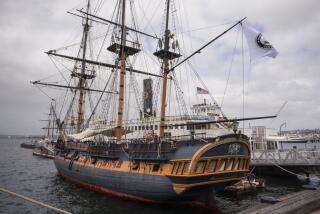Setting Sail for Polynesia
- Share via
In Tahiti there is a law--or at least an enforced tradition--that hotels should not be higher than a palm tree. I thought of that when the gleaming sails of the Wind Song unfurled silently as we left Papeete harbor.
We were not a hotel, of course, but certainly more than a yacht. And those square-rigged sails, on masts reaching 204 feet above the waterline, were not only higher than a palm tree but higher than the tops of some cruise vessels sometimes sighted in these South Pacific waters.
From the volcanic hills of Huahine to churchyards on Raiatea, the tall masts were the landmark I used to find my way back to the dock after a ramble on shore.
I had not visited French Polynesia in several years, and always before by air. Approaching from the sea stirs up wild visions; lagoons slowly grow more blue, reefs more fearsome, mountains more craggy. Natural ridges and ramparts resemble the man-made fortresses of medieval Europe--of Carcassonne or San Marino.
Islanders who gather for the Wind Song’s weekly call claim that the approaching ship creates equally entrancing illusions: its size and a silhouette changing under rain showers, or sunsets or a full moon.
I peered from the porthole of my cabin as we tied up on Raiatea. Schoolgirls with ponytails were jumping a long rope and chanting the cadence. Barefoot boys were pushing hoops along the pier. And, straight ahead, the town square was curtained in bright cotton: the blues and greens, the reds and golds of native pareus.
The pareu is an eminently useful garment, the boldly printed sarong of Polynesia, which also serves as a loincloth for men. It is a piece of cloth about four feet by six that can be used as a curtain, a tablecloth, a stole or a tied-at-the-waist cover-up for a swimsuit. A pareu also makes a dandy duffel bag.
A group of children from Raiatea were coming on board to sing and dance for us that evening. They arrived at the gangway with their crowns and costumes wrapped in pareus, which were tied at either end like bulging bananas, and slung over bare shoulders. Small drums also were carried in the sturdy cotton slings.
Before the show we strolled the streets, buying diet sodas and a French newspaper at the Magasin Yee Foo. We exchanged dollars at the air-conditioned Banque de Polynesie, where the lone teller told us that the rate had improved since we left Tahiti and that the spiky pink blossoms we had admired in the Papeete marketplace are called opuhi.
The teller, who had a bouquet of opuhi near her calculator, printed the name on a deposit slip.
The whole town smelled of cotton candy. We sniffed at the sweet evening breeze and realized that it was the heady scent of vanilla beans, which grow here in profusion.
At sea, amid the simple pleasures of these islands, the Wind Song performs as a computer-controlled marvel; courses can be altered, sails furled and unfurled from a sleek bridge of flashing screens and panels.
But there are officers on that bridge to do what a computer cannot: answer passengers’ questions.
“How much draft do we need?” a Floridian asked as we pulled up anchor in the clear waters of Moorea’s Cook’s Bay.
“About 13 feet,” replied Dag Dvergastein, the Norwegian captain who seems taller than a palm tree.
“But it says 42 feet on the side of the ship,” protested the Floridian.
The captain smiled.
“That’s 4.2 meters,” he said. “Only you Americans measure everything in feet.”
On the afternoon we left the lagoon of Bora Bora the breeze picked up and the captain set a southerly course. We were humming along at nine knots, savoring the odd, homey creak of a yacht.
“I love it,” a woman called as she leaned from the railing. “I wish we could go on like this forever.”
“But we cannot,” said the captain. “Pretty soon we must bring in the sails and turn on the engines to go to the east. If we kept on this course we would go to Cape Horn.”
Having been through the tumultuous waters off Cape Horn, I was content to have him turn on the power and continue our glide through the gentle seas of Polynesia.
More to Read
Sign up for The Wild
We’ll help you find the best places to hike, bike and run, as well as the perfect silent spots for meditation and yoga.
You may occasionally receive promotional content from the Los Angeles Times.






